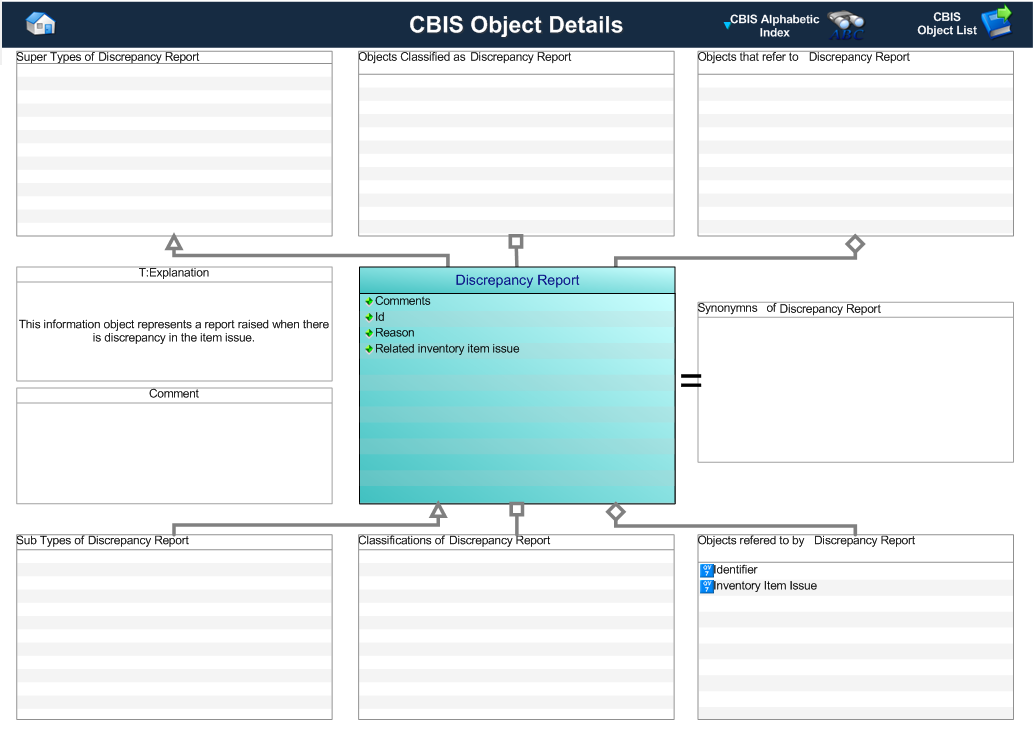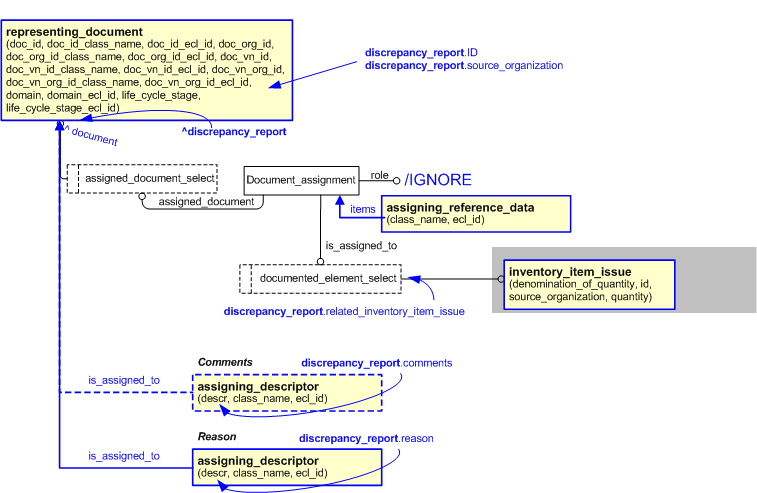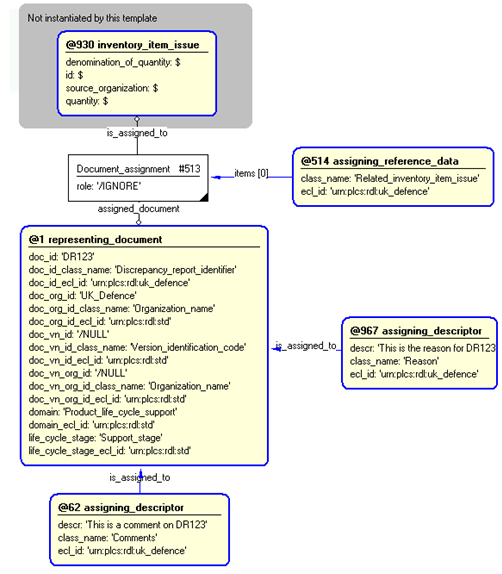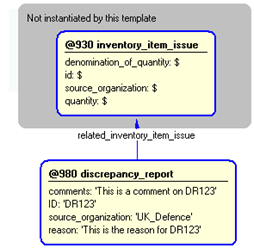Template:— discrepancy_report (dis_rep)
Context:— UK_Defence |
Date: 2009/04/17 11:14:08
Revision: 1.3
|
This section specifies the template discrepancy_report.
NOTE
The template has been defined in the context of
UK_Defence.
Refer to the business context for details of related templates.
NOTE
An explanation of a template and the associated instantiation path is
provided in the
Template overview
section.
This template describes how to represent a report raised when there is discrepancy in the item issue.
This information object represents a report raised when there is discrepancy in the item issue.
Figure 1 — Graphical Representation for Business Object Discrepancy Report
Discrepancy Report:
|
Attribute name
|
Attribute description
|
Attribute type
|
Optionality
|
| Comments |
These are any general comments about the discrepancy |
Intrinsic |
Optional |
| Id |
This is the identifier of the discrepancy report. |
intrinsic |
Mandatory |
| Reason |
This is the reason for the discrepancy.
EXAMPLES:
- Wrong item delivered
- Too many delivered
- Too few delivered
- Lost
- Packaging damaged on delivery.
|
intrinsic |
Mandatory |
| Related inventory item issue |
This is a reference to the related inventory item issue for which the discrepancy is reported. |
Relationship to Inventory Item Issue |
Mandatory |
Table 1 — Discrepancy Report attribute details:
The EXPRESS-G diagram in
Figure
2
shows the templates and EXPRESS entities that are required
to represent the template
"discrepancy_report".
The text highlighted in blue shows the template parameters.
Figure 2 — An EXPRESS-G representation of the Information model for discrepancy_report
The graphic for the template to be used in other EXPRESS-G diagrams
is shown in Figure
3
below.
Figure 3 — The graphical representation of the discrepancy_report template
The following input parameters are defined for this template:
These are any general comments about the discrepancy.
This is the identifier of the discrepancy report.
The organization that created the associated identifier. Additionally
a Person or Information System could be defined when either of these are the source; see Identifier template characterizations
This is the reason for the discrepancy.
This is a reference to the related inventory item issue for which the discrepancy is reported.
The following reference parameters are defined for this template:
Allow the
Document
entity instantiated in this path to be referenced when this template is used.
Note: The
Document
entity can be referenced in a template path by:
%^target = $discrepancy_report.discrepancy_report%
where
target
is the parameter to which the
Document
is bound.
The following parameter combinations specify a uniqueness constraint:
Unique constraint: Discrepancy_Report
Each instance of the
entity
(
Document)
within the data set shall be uniquely identified
by the following parameters on this
template (discrepancy_report) namely:
ID.
The
instance is
referenced by the following template parameter:
discrepancy_report.
The instantiation path shown below specifies the entities that are to be
instantiated by the template.
A description of templates and the syntax for the instantiation path is
provided in the
Templates Help/Information section.
-- Representing document /
representing_document(
doc_id=@ID,
doc_id_class_name='Discrepancy_report_identifier',
doc_id_ecl_id='urn:plcs:rdl:uk_defence',
doc_org_id=@source_organization,
doc_org_id_class_name='Organization_name',
doc_org_id_ecl_id='urn:plcs:rdl:std',
doc_vn_id=/NULL,
doc_vn_id_class_name='Version_identification_code',
doc_vn_id_ecl_id='urn:plcs:rdl:std',
doc_vn_org_id='/NULL',
doc_vn_org_id_class_name='Organization_name',
doc_vn_org_id_ecl_id='urn:plcs:rdl:std',
domain='Product_life_cycle_support',
domain_ecl_id='urn:plcs:rdl:std',
life_cycle_stage='Support_stage',
life_cycle_stage_ecl_id='urn:plcs:rdl:std')/
%^discrepancy_report = $representing_document.document%
-- [optional Comments] /
assigning_descriptor(
descr=@comments,
class_name='Comments',
ecl_id='urn:plcs:rdl:uk_defence',
is_assigned_to=^discrepancy_report)/
-- Reason /
assigning_descriptor(
descr=@reason,
class_name='Reason',
ecl_id='urn:plcs:rdl:uk_defence',
is_assigned_to=^discrepancy_report)/
-- related_inventory_item_issue Document_assignmentDocument_assignment.role = '/IGNORE'
Document_assignment.assigned_document ->
^discrepancy_report
Document_assignment.is_assigned_to ->
@related_inventory_item_issue%^rel_item =
Document_assignment%
/
assigning_reference_data(
class_name='Related_inventory_item_issue',
ecl_id='urn:plcs:rdl:uk_defence',
items=^rel_item)/
The following entities are instantiated with attributes as specified:
The instance diagram in Figure
4
shows an example of the EXPRESS entities and templates that are instantiated by the template:
/discrepancy_report(comments='This is a comment on DR123', ID='DR123', source_organization='UK_Defence', reason='This is the reason for DR123', related_inventory_item_issue='@930')/
(an illustration of the consolidated discrepancy_report template is shown in
Figure
5 below.)
Figure 4 — Entities instantiated by discrepancy_report template
The instance diagram in
Figure
5
shows the graphic symbol for the template that is to be
used in other instance diagrams. The example template is:
/discrepancy_report(comments='This is a comment on DR123', ID='DR123', source_organization='UK_Defence', reason='This is the reason for DR123', related_inventory_item_issue='@930')/
Figure 5 — Instantiation of discrepancy_report template
Characterizations
No common characterizations of the template
discrepancy_report
have been identified. However, the ISO 10303-239 EXPRESS model
may enable other assignments to the entities instantiated by the template.




